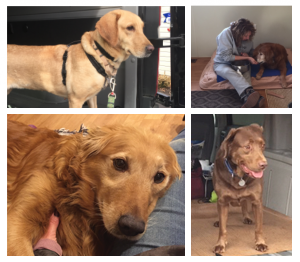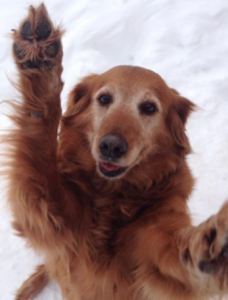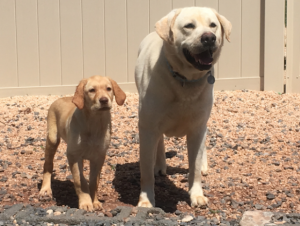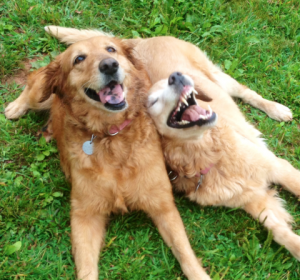 We’ve been successfully placing dogs into adoptive homes throughout eastern Pennsylvania, Delaware, Maryland, New Jersey, and beyond and have placed well over 6,000 dogs into new homes. We are a 501(c)(3) nonprofit organization relying on donations, our supporters, fundraising, and the proceeds from our events and online and on-site retail store, Pap’s Place for funding to support our mission.
We’ve been successfully placing dogs into adoptive homes throughout eastern Pennsylvania, Delaware, Maryland, New Jersey, and beyond and have placed well over 6,000 dogs into new homes. We are a 501(c)(3) nonprofit organization relying on donations, our supporters, fundraising, and the proceeds from our events and online and on-site retail store, Pap’s Place for funding to support our mission.
DVGRR has been recognized for our innovative work in rescuing and rehabilitating puppy mill breeder dogs. Through our nationally recognized Project Home Life (PHL) program, implemented in 2009, we work with these puppy mill survivors to help them transition successfully from the confines and horrors of life in a puppy mill to a normal home life with a loving family.
Because such a large number of rescued dogs arrive at our Golden Gateway campus from puppy mills, we have extensive experience in their rehabilitation. However, we also know that the training and conditioning we begin in the PHL program must continue after the dog is adopted. The dog’s journey continues, so we’ve created “Continuing the Journey” to help adopters continue to help their dogs!
![]()
Introduction
 Congratulations – you’ve adopted a very special DVGRR dog! You are about to embark on a journey that will ultimately make a huge difference in the life of your dog and will no doubt change your life as well.
Congratulations – you’ve adopted a very special DVGRR dog! You are about to embark on a journey that will ultimately make a huge difference in the life of your dog and will no doubt change your life as well.
You know you have the time, love, and patience to give your new dog a good life.
Indeed, these are all essential qualities and will serve you well. However, based on our experience with hundreds and hundreds of dogs participating in our PHL program, we know that they often need more than that to achieve even the smallest goals. “Continuing the Journey” is designed to help you continue the techniques we have already begun with your dog during their time in Project Home Life or while at the Lynne Glennon Sanctuary for Senior Goldens and Puppy Mill Survivors. The information we cover will help you work more effectively with your dog, especially during the all-important transition period into your home.
As you are no doubt aware, that new setting (i.e., your home) is likely to present many challenges for your dog. Puppy mill breeder dogs and other unsocialized dogs have usually never lived in a home before. Most have spent their lives in tiny cages, in barns, or kennel runs, isolated from other dogs and people. They have much to learn, and each dog will progress at their own pace.
What your dog needs most, and what you and your family must provide, is an unconditional acceptance of who they are and what their limitations may be for the balance of their lives. Go into this new relationship with the ability to visualize your dog’s potential but do not set expectations. You have made a life-long commitment to your new family member, and you should expect to weather a few difficulties and setbacks. Don’t worry, there will be many opportunities for celebration as well!
Some of the activities may seem silly at first (i.e., reading books to your dog or stepping through a hula hoop), but these have made quite an impact on dogs in our PHL program, and we know they can help. Use what you learn here to expand your relationship with your dog. Creativity is an important part of helping you succeed together!
The staff at DVGRR is always available to provide assistance as needed. Don’t hesitate to contact us at any time (717-484-4799 or adoption@dvgrr.org) with questions or concerns. Thank you from the bottom of our hearts for giving your special dog a second chance at life.
![]()
What Is a Puppy Mill Dog?
 First, let’s talk about what a puppy mill dog actually is. The Humane Society of the United States defines a puppy mill as a dog breeding operation that puts profit above the health of the dogs. A puppy mill does not have to have hundreds of dogs. Most of the dogs we get from puppy mills don’t come from huge breeding facilities. We do get some retired breeder dogs coming from responsible breeders as well and other dogs that might be considered farm dogs that have probably been bred a few times but mostly just roamed around on the farm. Another term you may see is “backyard breeder.” These are generally people who have a few dogs that they breed from time to time. They may be pets they breed or they may be farm dogs or dogs living in kennels. However, they all exhibit some degree of what we consider puppy mill behaviors.
First, let’s talk about what a puppy mill dog actually is. The Humane Society of the United States defines a puppy mill as a dog breeding operation that puts profit above the health of the dogs. A puppy mill does not have to have hundreds of dogs. Most of the dogs we get from puppy mills don’t come from huge breeding facilities. We do get some retired breeder dogs coming from responsible breeders as well and other dogs that might be considered farm dogs that have probably been bred a few times but mostly just roamed around on the farm. Another term you may see is “backyard breeder.” These are generally people who have a few dogs that they breed from time to time. They may be pets they breed or they may be farm dogs or dogs living in kennels. However, they all exhibit some degree of what we consider puppy mill behaviors.
We have also been getting a larger number of “leftovers” or puppies that were “too old to sell.” Once a puppy is about 10-12 weeks old, they are no longer the cute cuddly balls of fur and they become harder to sell. By about 14-16 weeks, the breeders are often ready to cut their losses and surrender them. These dogs have likely missed out on the very important experiences they should have received during their critical periods of socialization. So they, too, will probably exhibit some degree of the puppy mill behaviors.
When people see these dogs cowering from human touch, they ask if they have been abused. That’s possible, but it’s more likely they have just had a lack of human interaction. And the little interaction they received may or may not have been harsh but probably was not loving and caring. Anyone who knows about canine mental and emotional development knows that as puppies, dogs need to experience a lot of good, new things when they are young to become well-adjusted adults. Many of these dogs were born in a kennel, hutch, or barn and lived their whole lives that way.
Imagine living your entire life in your bedroom and the only things you saw daily were the same items in your room and out the window. Someone came and fed you twice a day and maybe cleaned up after you. But that’s it. Now suddenly you are plopped down into the middle of Grand Central Station. You’d likely cower from people and activity, too!
Dogs that grow up in kennels or barns have never seen a television, a vacuum cleaner, or heard the noise of a dishwasher. Seeing people just sitting and having an animated conversation may even be new to them. They will tend to be fearful of quick movements, loud noises, walking through doorways, walking on different flooring surfaces, different looking people, and so many things that we take for granted in our modern world. Even the “farm dogs” haven’t experienced life in a modern home environment.
Some dogs come to us terrified of people, some come to us wanting to interact but are afraid to approach, and some will come acting as a normal dog. But even if they do seem well-socialized when they arrive, we usually find some part of our modern world that gives them pause.
![]()
Signs of Fear
 Recognizing the signs of fear in your dog can help you know how to respond by getting them out of the fearful situation or end whatever activity is too overwhelming. It will help you know what their stress thresholds are and understand how much of a certain activity your dog can handle. It’s important to understand your dog is not being “stubborn” if they, for example, refuse to walk on leash or come to you for petting. They aren’t being stubborn; instead they are scared. It will also help you see when these signs of fear decrease, then you know your dog is becoming more comfortable and making progress!
Recognizing the signs of fear in your dog can help you know how to respond by getting them out of the fearful situation or end whatever activity is too overwhelming. It will help you know what their stress thresholds are and understand how much of a certain activity your dog can handle. It’s important to understand your dog is not being “stubborn” if they, for example, refuse to walk on leash or come to you for petting. They aren’t being stubborn; instead they are scared. It will also help you see when these signs of fear decrease, then you know your dog is becoming more comfortable and making progress!
- Frozen in place
- Cowering
- Avoiding eye contact
- Lip licking
- Hyper-vigilance
- Whites of eyes showing
- Closed mouth
- Tail tucked
- Lowered ears
- Pacing
- Spinning/Circling
- Trembling
- Frantic running
- Drooling
- Urinating/Defecating
![]() Mentor Dogs
Mentor Dogs
 Because dogs are naturally social animals, the best teacher for a shy dog is another dog. We do require most of the puppy mill dogs that come through our program to go to a home with a mentor dog. We have found that, hands down, the most effective way to help these dogs adjust and adapt is a mentor dog. As the term implies, the mentor dog serves as a teacher, tutor, or trail guide through life for the less confident dog. Dogs do not require training to be a good mentor dog.
Because dogs are naturally social animals, the best teacher for a shy dog is another dog. We do require most of the puppy mill dogs that come through our program to go to a home with a mentor dog. We have found that, hands down, the most effective way to help these dogs adjust and adapt is a mentor dog. As the term implies, the mentor dog serves as a teacher, tutor, or trail guide through life for the less confident dog. Dogs do not require training to be a good mentor dog.
For dogs that never had the benefit of growing up in a typical human household, having a mentor dog to guide them through daily life can be invaluable. Dogs know how to talk and listen to other dogs so much better than people. Having another dog around provides two key elements in the fearful dog’s adjustment to a new home.
First, they provide comfort and a sense of familiarity that helps the fearful dog better negotiate the new and often overwhelming aspects of their new environment.
Second, by observing the mentor dog accept and seek out attention from humans, casually respond to household sights and sounds, and stay relaxed in new circumstances, the fearful dog learns to do the same.
The best mentor dogs are interactive and friendly with people and other dogs but not too pushy. They are active enough to have the energy to interact. They are reliable and comfortable in new and changing situations. They are good at communicating and listening to other dogs’ body language. They understand and respect if they are being too pushy with a fearful dog.
Even if your dog does not fit the profile of the perfect mentor dog, as long as they get along with other dogs and aren’t anxious or fearful, they should be able to show your fearful dog the ropes of living in your house.
![]()
The Safe Spot
 What is a safe spot? This is an area that your dog will choose as their place to retreat when things get stressful. It is a place where they find safety and comfort. You can create a safe spot in your home that includes an opened-door crate covered with a blanket or a spot with a dog bed and some toys. More than likely, your dog will choose their own safe spot. In the beginning, if your dog is afraid of venturing out of the safe spot, you may need to place their water and food bowls in this area. It is important for your dog to have a space like this to go to when they need time to decompress. Remember, most mill dogs have lived in very small spaces. They are not accustomed to having freedom to move around in homes from room to room. It will take some time for your dog to feel comfortable to venture out of their safe spot and move around the house, but with patience and gentle encouragement, they will progress. After a few months, if your dog has not yet ventured from their safe spot at all, you may want to help them explore. Gradually introduce new rooms or areas by walking them on leash around the home or encourage them with tasty treats or their mentor dog.
What is a safe spot? This is an area that your dog will choose as their place to retreat when things get stressful. It is a place where they find safety and comfort. You can create a safe spot in your home that includes an opened-door crate covered with a blanket or a spot with a dog bed and some toys. More than likely, your dog will choose their own safe spot. In the beginning, if your dog is afraid of venturing out of the safe spot, you may need to place their water and food bowls in this area. It is important for your dog to have a space like this to go to when they need time to decompress. Remember, most mill dogs have lived in very small spaces. They are not accustomed to having freedom to move around in homes from room to room. It will take some time for your dog to feel comfortable to venture out of their safe spot and move around the house, but with patience and gentle encouragement, they will progress. After a few months, if your dog has not yet ventured from their safe spot at all, you may want to help them explore. Gradually introduce new rooms or areas by walking them on leash around the home or encourage them with tasty treats or their mentor dog.


